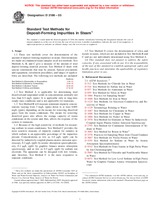Potřebujeme váš souhlas k využití jednotlivých dat, aby se vám mimo jiné mohly ukazovat informace týkající se vašich zájmů. Souhlas udělíte kliknutím na tlačítko „OK“.
ASTM D2186-05
Standard Test Methods for Deposit-Forming Impurities in Steam
Automaticky přeložený název:
Standardní metody zkoušek pro vkladů tvořících nečistoty v Steam
NORMA vydána dne 1.6.2005
Informace o normě:
Označení normy: ASTM D2186-05
Poznámka: NEPLATNÁ
Datum vydání normy: 1.6.2005
Kód zboží: NS-19544
Počet stran: 7
Přibližná hmotnost: 21 g (0.05 liber)
Země: Americká technická norma
Kategorie: Technické normy ASTM
Anotace textu normy ASTM D2186-05 :
Keywords:
deposit-forming, electrical conductivity, evaporate, gravimetric, impurities, Larsen-Lane, sodium tracer, steam, ICS Number Code 13.060.50 (Examination of water for chemical substances)
Doplňující informace
| 1. Scope | ||||||||||||||||||||||||||||||||||||||||
|
1.1 These test methods cover the determination of the amount of deposit-forming impurities in steam. Determinations are made on condensed steam samples in all test methods. Test Methods A, B, and C give a measure of the amount of total deposit-forming material present; Test Method D deals with special constituents that may be present. Special precautions and equipment, calculation procedures, and ranges of applicability are described. The following test methods are included:
1.2 Test Method A is applicable for determining total dissolved and suspended solids in concentrations normally not less than 0.4 mg/L (ppm). It is applicable only to long-time steady-state conditions and is not applicable for transients. 1.3 Test Method B will measure minimum impurity concentrations varying from 3 mg/L (ppm) down to at least 0.005 mg/L (ppm), depending on the means for removing dissolved gases from the steam condensate. The means for removing dissolved gases also affects the storage capacity of steam condensate in the system and, thus, affects the response of the system to transients. 1.4 Because of the high sensitivity of methods for measuring sodium in steam condensate, Test Method C provides the most sensitive measure of impurity content for samples in which sodium is an appreciable percentage of the impurities present. Concentrations as low as 4.0 g/L (ppb) can be detected by inductively coupled plasma atomic emission spectroscopy, 0.2 g/L (ppb) by atomic absorption spectrophotometry, 0.1 g/L (ppb) by graphite furnace atomic absorption spectroscopy, and as low as 0.5 g/L (ppb) by sodium ion electrode. The apparatus can be designed with low volume, and, therefore, Test Method C is the most responsive to transient conditions. 1.5 Test Method D covers the determination of silica and metals in steam, which are not included in Test Methods B and C and are not individually determined using Test Method A. 1.6 This standard does not purport to address the safety concerns, if any, associated with its use. It is the responsibility of the user of this standard to establish appropriate safety and health practices and determine the applicability of regulatory limitations prior to use. |
||||||||||||||||||||||||||||||||||||||||
| 2. Referenced Documents | ||||||||||||||||||||||||||||||||||||||||
|




 Cookies
Cookies
